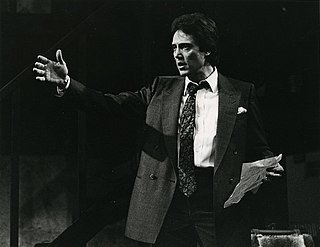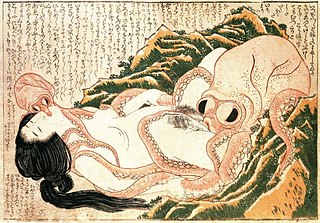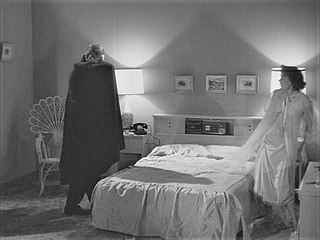A director's cut is an edited version of a film that is supposed to represent the director's own approved edit. "Cut" explicitly refers to the process of film editing; in preparing a film for release, the director's cut is preceded by the assembly and rough editor's cut and usually followed by the final cut meant for the public film release.

Voice-over is a production technique where a voice—that is not part of the narrative (non-diegetic)—is used in a radio, television production, filmmaking, theatre, or other presentations. The voice-over is read from a script and may be spoken by someone who appears elsewhere in the production or by a specialist voice actor. Synchronous dialogue, where the voice-over is narrating the action that is taking place at the same time, remains the most common technique in voice-overs. Asynchronous, however, is also used in cinema. It is usually prerecorded and placed over the top of a film or video and commonly used in documentaries or news reports to explain information.

A screenplay, or script, is a written work by screenwriters for a film, television program, or video game. These screenplays can be original works or adaptations from existing pieces of writing. In them, the movement, actions, expression and dialogues of the characters are also narrated. A screenplay written for television is also known as a teleplay.

In theatre, a monologue is a speech presented by a single character, most often to express their thoughts aloud, though sometimes also to directly address another character or the audience. Monologues are common across the range of dramatic media, as well as in non-dramatic media such as poetry. Monologues share much in common with several other literary devices including soliloquies, apostrophes, and asides. There are, however, distinctions between each of these devices.

A film transition is a technique used in the post-production process of film editing and video editing by which scenes or shots are combined. Most commonly this is through a normal cut to the next shot. Most films will also include selective use of other transitions, usually to convey a tone or mood, suggest the passage of time, or separate parts of the story. These other transitions may include dissolves, L cuts, fades, match cuts, and wipes.

Tentacle erotica or tentacle rape is a type of pornography most commonly found in Japan which integrates traditional pornography with elements of bestiality and a fantasy, horror, or science-fiction theme. It is found in some horror or hentai titles, with tentacled creatures having sexual intercourse, predominantly with females. Tentacle erotica can be consensual but frequently contains elements of rape.

In filmmaking, the 180-degree rule is a basic guideline regarding the on-screen spatial relationship between a character and another character or object within a scene. By keeping the camera on one side of an imaginary axis between two characters, the first character is always frame right of the second character. Moving the camera over the axis is called jumping the line or crossing the line; breaking the 180-degree rule by shooting on all sides is known as shooting in the round.
Screenwriting or scriptwriting is the art and craft of writing scripts for mass media such as feature films, television productions or video games. It is often a freelance profession.

Speech balloons are a graphic convention used most commonly in comic books, comics, and cartoons to allow words to be understood as representing the speech or thoughts of a given character in the comic. Often, a formal distinction is made between the balloon that indicates thoughts and the one that indicates words spoken aloud; the balloon that conveys thoughts is often referred to as a thought bubble or conversation cloud.
A soundtrack album is any album that incorporates music directly recorded from the soundtrack of a particular feature film or television show. The first such album to be commercially released was Walt Disney's Snow White and the Seven Dwarfs, the soundtrack to the film of the same name, in 1938. The first soundtrack album of a film's orchestral score was that for Alexander Korda's 1942 film Rudyard Kipling's Jungle Book, composed by Miklós Rózsa. However, this album added the voice of Sabu, the film's star, narrating the story in character as Mowgli.

A fake Shemp is someone who appears in a film as a replacement for another actor or person. Their appearance is disguised using methods such as heavy make-up, filming from the back, dubbing in audio and splicing in past footage from the original actor's previous work, using a sound-alike voice actor, or using partial shots of the actor. Coined by film director Sam Raimi, the term is named after Shemp Howard of the Three Stooges, whose sudden death in 1955 necessitated the use of these techniques to finish the films to which he was already committed. Once somewhat commonplace throughout the 20th century, the use of fake Shemps to emulate living people is now forbidden under Screen Actors Guild contracts, largely because of a lawsuit filed by Crispin Glover — following his replacement in Back to the Future Part II — that determined that the method violates the original actor's personality rights. The method continues to be used in cases, such as Shemp's, where the original actor is deceased and permission from the deceased actor's estate is granted.
Majhi is an Indo-European language spoken in parts of Nepal and some small pockets of neighboring India.:1 The language is associated with the Majhi people, an ethnic group in those regions who dwell historically near the Saptakoshi River and its tributaries and elsewhere in central and eastern Nepal. The Majhi people generally subsist off of work associated with rivers, including fishing and ferrying.:2 Majhi is written using the Devanagari writing system.

Alice in Wonderland is a dark ride in Fantasyland at Disneyland in Anaheim, California. Based on the 1951 animated Disney film of the same name, the attraction resides next to a second ride, the Mad Tea Party, based on a scene in that same adaptation.
Procedure words or prowords are words or phrases limited to radio telephone procedure used to facilitate communication by conveying information in a condensed standard verbal format. Prowords are voice versions of the much older prosigns for Morse code first developed in the 1860s for Morse telegraphy, and their meaning is identical. The NATO communications manual ACP-125 contains the most formal and perhaps earliest modern (post-WW-II) glossary of procedure words, but its definitions have been adopted by many other organizations, including the United Nations Development Programme, the U.S. Coast Guard, the Rhode Island Department of Emergency Management, Civil Air Patrol, Military Auxiliary Radio System, and others.
In the post-production process of film editing and video editing, a cut is an abrupt, but usually trivial film transition from one sequence to another. It is synonymous with the term edit, though "edit" can imply any number of transitions or effects. The cut, dissolve and wipe serve as the three primary transitions. The term refers to the physical action of cutting film or videotape, but also refers to a similar edit performed in software; it has also become associated with the resulting visual "break".

A play is a work of drama, usually consisting mostly of dialogue between characters and intended for theatrical performance rather than just reading. The writer of a play is a playwright.
A non-player character (NPC) is any character in a game which is not controlled by a player. The term originated in traditional tabletop role-playing games where it applies to characters controlled by the gamemaster or referee rather than another player. In video games, this usually means a character controlled by the computer that has a predetermined set of behaviors that potentially will impact game play, but will not necessarily be true artificial intelligence.
The Dorset dialect is the traditional dialect spoken in Dorset, a county in the West Country of England. Stemming from Proto-Norse and Saxon, it is preserved in the isolated Blackmore Vale, despite it somewhat falling into disuse throughout the earlier part of the 20th century, when the arrival of the railways brought the customs and language of other parts of the country and in particular, London. The rural dialect is still spoken in some villages however and is kept alive in the poems of William Barnes and Robert Young.
This glossary of motion picture terms is a list of definitions of terms and concepts related to motion pictures, filmmaking, cinematography, and the film industry in general.









